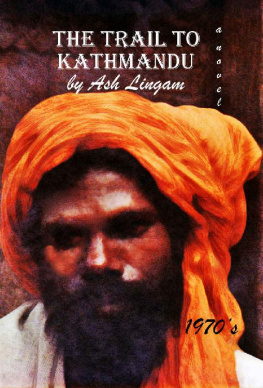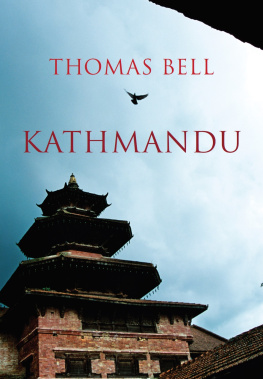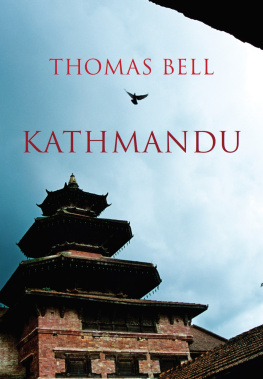Ash Lingam - The Trail To Kathmandu (1970s): Travel Memoirs of a Hippy
Here you can read online Ash Lingam - The Trail To Kathmandu (1970s): Travel Memoirs of a Hippy full text of the book (entire story) in english for free. Download pdf and epub, get meaning, cover and reviews about this ebook. year: 2016, genre: Detective and thriller. Description of the work, (preface) as well as reviews are available. Best literature library LitArk.com created for fans of good reading and offers a wide selection of genres:
Romance novel
Science fiction
Adventure
Detective
Science
History
Home and family
Prose
Art
Politics
Computer
Non-fiction
Religion
Business
Children
Humor
Choose a favorite category and find really read worthwhile books. Enjoy immersion in the world of imagination, feel the emotions of the characters or learn something new for yourself, make an fascinating discovery.
- Book:The Trail To Kathmandu (1970s): Travel Memoirs of a Hippy
- Author:
- Genre:
- Year:2016
- Rating:3 / 5
- Favourites:Add to favourites
- Your mark:
- 60
- 1
- 2
- 3
- 4
- 5
The Trail To Kathmandu (1970s): Travel Memoirs of a Hippy: summary, description and annotation
We offer to read an annotation, description, summary or preface (depends on what the author of the book "The Trail To Kathmandu (1970s): Travel Memoirs of a Hippy" wrote himself). If you haven't found the necessary information about the book — write in the comments, we will try to find it.
Ash Lingam: author's other books
Who wrote The Trail To Kathmandu (1970s): Travel Memoirs of a Hippy? Find out the surname, the name of the author of the book and a list of all author's works by series.
The Trail To Kathmandu (1970s): Travel Memoirs of a Hippy — read online for free the complete book (whole text) full work
Below is the text of the book, divided by pages. System saving the place of the last page read, allows you to conveniently read the book "The Trail To Kathmandu (1970s): Travel Memoirs of a Hippy" online for free, without having to search again every time where you left off. Put a bookmark, and you can go to the page where you finished reading at any time.
Font size:
Interval:
Bookmark:
The Trail to Kathmandu
(1970s)
by Ash Lingam
Copyright 2016 by Ash Lingam
All rights reserved.
This book or parts thereof may not be reproduced in any form, stored in any retrieval system, or transmitted in any form by any meanselectronic, mechanical, photocopy, recording, or otherwisewithout prior written permission of the publisher, except as provided by United States of America copyright law. For permission requests, write to the publisher, at Attention: Permissions Coordinator, at the address below
The Trail to Kathmandu (1970s)
A Novel
ISBN: 10:1539777278
ISBN: 13: 978 1539777274
Creative Commons Attribution No: 1609219239974

Camel in New Delhi
Thanks to my family for their support.
Table of Contents:
Forward
This is a history of the life a Hippy in the 1970s. In the midst of the Hippy Movement. A young man, embarking on a four-year journey to the ends of the Earth, testing his limitations in every way possible way.
Escaping modern society, becoming a Hippy in a Middle-Class World and completely Dropping Out. We follow him as he travels some 13,000 miles overland in those four years and the countries in which he visited and lived. In such exotic destinations as Turkey, Iran, Afghanistan, India, and Nepal.
Above all, it is about how one's life can be moved from one path to another due to the influences of our environment and moments of opportunity in one's life.
This book takes us on journeys and to places that can no longer be visited, no longer exist or have been changed by the influences of war and politics. There was a small window in time that permitted such travels.
It begins at a point when International borders were unclear, laws were lax, and one could survive in ways that today are neither acceptable nor possible. For this young man, it was a chance to look for the unknown and the unexplained in the most profound corners of Asia .
The Author
The strangely clad, long-haired young man had just boarded the international commercial flight. It flew out of Miami, Florida and started the long haul to the capital of India, New Delhi. How did he get to this point in his young life, where he was ready to leave everything behind and move on to faraway lands? Places he had only read about up to now? Who knows? He had read several books on Eastern cultures, and there were a few that motivated him, to the point of joining this small group of people, who challenged a modern social life that their parents and peers expected them to take.
The flight seemed to take forever. From Miami to New York, and then boarding Indian Air Lines for his first glimpse of the Indian culture. His immediate agenda was to visit the religious event, Kumbh Mela,* and get high with the Sadhus.* Other than that, he had few plans and even less money. It would appear he was not fully aware of what he was getting into.
As it was just turning dusk, the 747 was making its approach to the New Delhi airport. There was a low cloud of smoke covering the entire city from the millions of fires coming from the population's dwellings. It was creating a strange reflection of light above the mass of buildings while nearing the capital's airport, to land on the tarmac with a hard jolt, as if making a statement of his arrival.
What he remembered about those first moments in the Indian capital, was an intense, close heat and a pungent odor he had never experienced. A mixture of incense, wood and dung fires came from each home across the city night. After passing through customs and exiting onto the street, he encountered the overwhelming masses of people that were everywhere one looked.
It gave the man some second thoughts about such an adventure, although no going back now. It may have been better if he had gone with a friend, but he knew no one who had his desires for this particular adventure. The young man was destined to spend the next couple of years traveling alone or moving along these established trails, with people from all walks of life who he would meet along his journey.
This Levi clad hippy traveled by backpack, as was the standard method of the hippy movement. Half of his belongings consisted of books on Hinduism, Buddhism, and yoga. His travel guide was a book written by a social dropout named Richard Alpert, who later changed his name to Baba Ram Dass.
He and Timothy Leary, both psychology professors at Berkley and Harvard universities, were expelled for experimenting with LSD on humans. This book was a philosophical guide for many in the Indian part of the hippy trail. He not so much told you where to go, but what to look to achieve. More of a collection of unusual thoughts that only a person from that time will understand.
The objective was to Be here now' as Richard explained it. Not here yesterday, not here tomorrow, just be here now in the moment. Perhaps to enhance your capacity to absorb new ideas and the beliefs from other cultures through the consumption psychoactive herbs and drugs.
One of his stories told were of a Tibetan Monk. The Monk was on the ground when a tiger appeared, and he had to quickly climb a vine that grew up to the top of a cliff to save himself. When he arrived halfway to the top, another tiger appeared above him and he had to stop his climb.
Then the monk noticed right where he had stopped climbing the vine, was a little crop of strawberries. He picked one after another savoring each, as they were the best he could remember ever having eaten. Oblivious to the danger below and above him as he was living in that precise moment. Not past, nor future, only the present.
At the airport, the arriving passengers were overwhelmed with locals trying to get them into their rickshaws, Taxis and motor rickshaws to transport them to some hotels. Usually recommended by each one of these transport Wallas to assure their commission.
We must remember at this date in time, Google and the Internet did not yet exist, so the only manner to struggle to find your way around was talking to other travelers who were already on the trail. The young man met a girl in the airport who was from the US as well and suggested a room a government official rented on the side to earn some black-market dollars. So, for the first night, he stayed there. In the morning, realizing this was not the path he wanted to start on, he went straight off to the middle of the city, as the government official's room was too posh and expensive.
He had already parted with the American girl, because she was looking for a different India than he imagined. His second attempt at securing a place to sleep once again resulted in an error. It had seemed cheap to the green American with dollars, although somewhat crudely furnished.
After the first night, the manager took him aside and very politely explained to him that, "This hotel is not for hippy types, Sahib. We suggest you go to the guest house of Mrs. Marwah's, on 31 Hanuman Road behind Mohan Sing Palace." All the time, wobbling his head sideways, as Indians do in affirmation.
Off he went to Mrs. Marwah's guesthouse. A local stop for hippy travelers, arriving on the overland trail, inbound flights like his or people returning from such exotic places as Bombay, Goa, and Kathmandu.
Mrs. Marwah's guest house consisted of one large tent with Indian beds called palangs*. On the interior of this tent, it was full of Indian beds made of wood and rope, with just enough room to move between each row of cots to get to your designated sleeping spot. The persons who considered themselves hippies, in general, had very little or no money. Resulting in this being the most economical way to travel. It cost less than two dollars per day for the group dormitory, which consisted of a bed to pass the night on, along with the use of the guesthouse services if they, in fact, could be called that.
Font size:
Interval:
Bookmark:
Similar books «The Trail To Kathmandu (1970s): Travel Memoirs of a Hippy»
Look at similar books to The Trail To Kathmandu (1970s): Travel Memoirs of a Hippy. We have selected literature similar in name and meaning in the hope of providing readers with more options to find new, interesting, not yet read works.
Discussion, reviews of the book The Trail To Kathmandu (1970s): Travel Memoirs of a Hippy and just readers' own opinions. Leave your comments, write what you think about the work, its meaning or the main characters. Specify what exactly you liked and what you didn't like, and why you think so.








